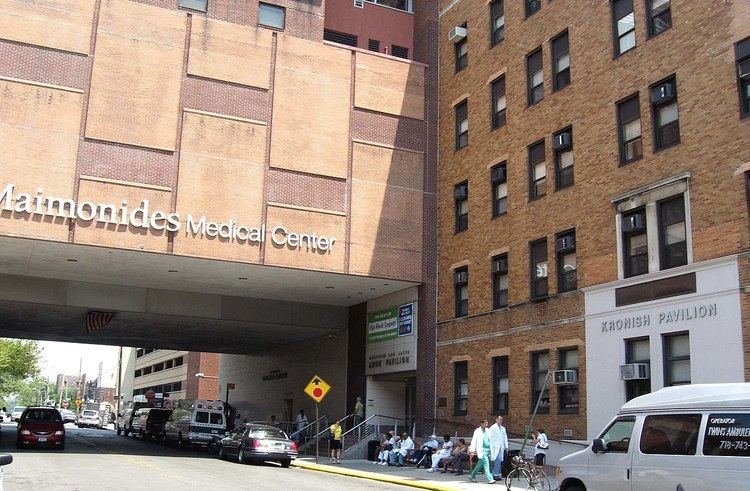Care system Private Emergency department Yes Number of beds 711 | Phone +1 718-283-6000 Founded June 1911 | |
 | ||
Affiliated university Albert Einstein College of Medicine, SUNY Downstate Medical Center College of Medicine , Icahn School of Medicine at Mount Sinai, New York College of Osteopathic Medicine Address 4802 10th Ave, Brooklyn, NY 11219, USA CEO Pamela S. Brier (May 2003–) Affiliated universities Albert Einstein College of Medicine Similar NYU Lutheran, Calko Medical Center, Ten Svetlana B MD, Dr Samantha Cohen - MD, MMC Ob‑Gyn Womens Profiles | ||
Dr elliot borgen cardiologist at maimonides medical center
Maimonides Medical Center is a non-profit, non-sectarian hospital located in Borough Park, in the New York City borough of Brooklyn, in the U.S. state of New York. Maimonides is both a treatment facility and academic medical center with 711 beds, and more than 70 primary care and sub-specialty programs. As of August 1, 2016 Maimonides Medical Center is an adult and pediatric trauma center, being Brooklyn's only pediatric trauma center.
Contents
- Dr elliot borgen cardiologist at maimonides medical center
- Software defined storage in action at maimonides medical center
- Early years
- Deadly fire
- Expansion
- Affiliation
- Landmarks
- Information technology
- Five Centers of Excellence
- Diversity
- New York State Department of Health Designations
- Notable deaths
- References
Software defined storage in action at maimonides medical center
Early years
The institution was founded in 1911 as the New Utrecht Dispensary. Several small dispensaries merged with Utrecht in 1919 to form the Israel Hospital of Brooklyn. In 1920 it merged with Zion hospital and became United Israel Zion Hospital, later renamed to Israel Zion Hospital.
The United Israel Zion Hospital and Beth Moses Hospital merged in 1947 to give rise to the Maimonides Medical Center. The institution is named after Rabbi Moshe Ben Maimon, a 12th century Jewish philosopher.
Deadly fire
In 1993, a faulty respirator supplying oxygen to an elderly woman exploded, killing her and two other patients. Investigators said that an electrical fault in the machine had caused it to ignite. The fire created a blast fed by pure oxygen, which sent a fireball through a seventh-floor window. Fire officials said that two patients were burned to death, and a third patient across the hall, died of smoke inhalation. The faulty respirator was manufactured by Puritan Bennett. Barry M. Spero, the hospital's president at the time, said that biomedical engineers routinely checked the equipment according to specifications by the manufacturer. He referred to the incident as, "truly a catastrophic disaster."
Expansion
The Maimonides Medical Center last expanded its emergency department in 1997 with the opening of the Harry and Jeanette Weinberg Emergency Center. Beginning in September 2007 and continuing through the end of the year, the Medical Center started construction on additional space in the new building at the corner of 48th Street and Fort Hamilton Parkway. The New section of the Emergency Room has already been completed and is presently serving patients.There are 2 wings, one is known as the South side and the other referred to as the North side, the main differences in both side are the acuity or severity of patients seen. In 2015 Maimonides Medical Center broke ground on 3.4 million square feet of medical office space, which will allow patients to visit an array of health care providers in the same building.
Affiliation
In February 2013, Maimonides Medical Center, the Albert Einstein College of Medicine of Yeshiva University, and Montefiore Medical Center signed an affiliation agreement that made Maimonides a university hospital and the Brooklyn campus of Albert Einstein College of Medicine.
Landmarks
The Maimonides Medical Center was the place of several innovations in clinical science. In 1961, the commercial pacemaker was developed in the Maimonides Research Laboratory. The same laboratory was co-developer of Intra-aortic balloon pump in 1970. Implantation of first partial mechanical heart was performed in the hospital in 1966. In the following year, the second human heart transplant in the world (first in the US) was performed in the medical center by Dr. Adrian Kantrowitz. Several technical feats were achieved by the clinicians in the hospital, such as the first needle aspiration biopsy in US (in 1981), first robotic surgery for pediatric patients in US (in 2001), first angioplasty during a heart attack (in 1983).
In 2007, the New York Times reported that of an analysis of about 5,000 hospitals by the Department of Health and Human services, Maimonides was one of the 50 hospitals with the lowest mortality rates. In 2010, Maimonides received the HealthGrades Distinguished Hospital Award for Clinical Excellence, ranking it among the top 5% of hospitals in the entire nation for overall quality outcomes. Maimonides was also listed among the top 5 individual hospitals in New York State for cardiology services, coronary interventional procedures, stroke treatment, and gastrointestinal medical services.
Information technology
Maimonides Medical Center is a pioneer in implementing health information technology. and is consistently ranked one of the "Most Wired" Hospitals.
Five Centers of Excellence
Diversity
Due to its culturally diversified location, Maimonides has recruited multilingual physicians, nurses and staff. 67 languages are available through a commercially available translator service at Maimonides Medical Center.
